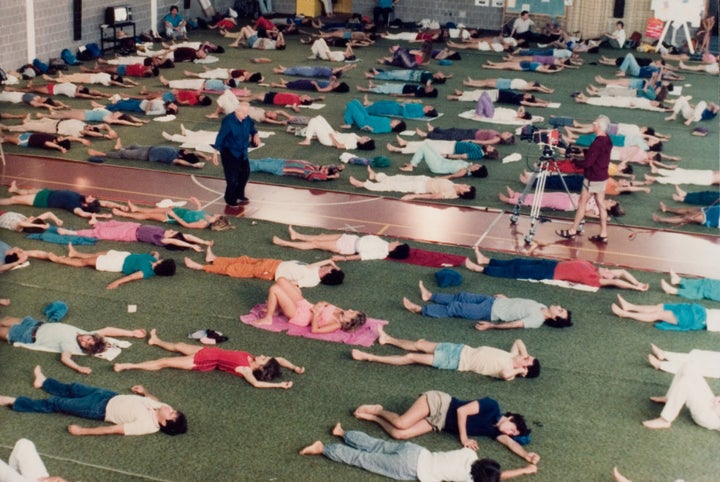
Moshe Feldenkrais, D.Sc., teaching his method of somatic education in Amherst, MA (1980). His method is now taught in trainings all over the world.
The world is shifting in ways unforeseen even a year ago. Forget orange: change is the new black. Brexit and the results of the US election, unanticipated by many, are but two examples in addition to other changes permeating our lives, such as technological advances, shifts in weather patterns and, also, the process of aging. If there is one thing that anyone can do to better prepare themselves to respond to both life’s inevitabilities and its vagaries, it’s finding a practitioner of the Feldenkrais Method and taking a class called Awareness Through Movement.
Lying on the floor and moving slowly, with awareness but without a goal, might seem counterintuitive to those who identify with vigorous and purposeful action or who are motivated by a sense of urgency. But Feldenkrais lessons are, paradoxically, one of the more accessible ways to learn how to more fully inhabit one’s life. Lying down could very well be the first step to standing up for oneself in an uncertain world. The Feldenkrais Method also helps develop the capacity to respond to changes in one’s personal circumstances or surroundings with greater skill, rather than defaulting to a more limited, stress-influenced repertoire (e.g. fight, flight, freeze) that might offer a momentary reprieve but is not transformative or empowering over the long term. While many people, myself included, only stumble across the Feldenkrais Method when an injury, chronic pain or another treatment-defying condition leads us to it, this modality also helps those without pressing concerns discover just how much they can trust their bones and themselves. Learning to rely more on the skeleton for daily movement, even the prosaic act of getting out of bed, frees up energy and vitality normally devoted to muscling through life. In a culture whose mantras include “no pain, no gain” and “work hard, play hard”, it can be surprising to learn that less effort often leads to better results and that one can move quickly without adding unnecessary tension, leaving more energy to pursue what matters to us.
The roots of the method remain pertinent today, with the world in flux and people all over the globe leaving their homes to seek refuge and opportunity in other lands. Moshe Feldenkrais, born in 1904 in what is now Ukraine, grew up amidst pogroms and the tumult of the First World War. In 1918 he left home with a pistol in his boot and a knapsack on his back and, over six months, walked across war torn Europe with a band of other youth to what was then Palestine. As a young man he worked as a cartographer for the British survey office, played soccer and learned Jujitsu so he could defend himself against armed attackers and teach self-defense to other Jews, prohibited by the British Mandate from carrying weapons. In the aftermath of a soccer mishap that severely injured his left knee, he moved to Paris in 1930 to study engineering and, a few years later, caught the attention of Judo founder Jigoro Kano. By 1936 Moshe Feldenkrais earned his Judo black belt. In 1940, he narrowly escaped the Nazi invasion of France, a traumatic ordeal that reactivated his knee injury. As meticulously explained in Moshe Feldenkrais: A Life in Movement, a biography by Mark Reese, these and other turning points of his riveting life story influenced the development of his method of somatic education, whose subtle movements and gentle approach belie both their dramatic origins and potent efficacy. Having trained in the martial arts and fled turmoil and fascism, Dr. Feldenkrais knew in his bones the importance of being able to reverse one’s movement, to either avoid being felled by an assailant or to evacuate when one’s life depended on it. He skillfully and very subtly translated “reversibility” into his repertoire of accessible movement lessons into which I’ve immersed myself. Indeed, simply learning how to sit down and get up from a chair so that I could reverse direction during any part of the trajectory, without either thunking into the seat or clenching my leg muscles or using my arms to stand, taught me very directly that much of my movement, and therefore my life, had been a lopsided dance of excessive effort and, when that left me exhausted, collapse. To learn how to evenly distribute effort across the skeleton makes movement lighter and easier, a state change that is nothing short of astonishing.
When life throws a curve ball, it’s an opportunity to check in with ourselves and, if we have the capacity for compassionate self-reflection, to assess how we responded or plan to respond. The Feldenkrais Method offers a non-judgmental way to get acquainted with our habits of movement, a gateway to our emotions, sensations and thoughts. In doing so we discover greater choice and therefore more resilience. As Dr. Feldenkrais once said, “What I'm after isn't flexible bodies, but flexible brains.” If we spend time in Feldenkrais lessons cultivating that flexibility, we might surprise or even surpass ourselves in moments of challenge. In extreme situations, such as those that Moshe Feldenkrais and many other refugees and immigrants lived through, being able to move rapidly and easily can ensure one’s survival. For those of us whose physical lives are not on the line, resilience can help us adapt more readily to change and/or to summon potent responses. We can learn to embody freedom and ease regardless of what is happening around us, and to engage with even the most difficult circumstances, whether personal, societal, or global, in a way that is more sustainable.
The beauty of the Feldenkrais Method is that, as an educational modality, it doesn’t try to fix, heal or cure anything or, even, solve problems. It helps people discover how to maximize their physical, expressive and creative potential by using themselves and their attention more astutely so as not waste effort or subconsciously sabotage themselves. As Moshe Feldenkrais said, “The object of this learning is to remove outside authority from your inner life.” With so much at stake in the world, if we all did a little bit of Feldenkrais, it could go a long way.
Other reading:
